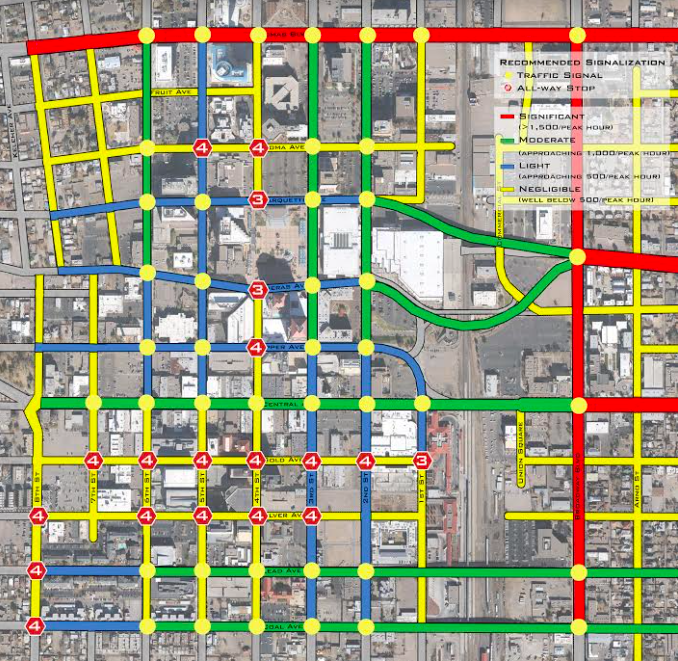Streetsblog the exclusive right to publish a series of excerpts from Jeff Speck’s new book, Walkable City Rules(Island Press). These "rules" will be shared in conjunction with the book’s release this month.
Rule 76: Replace Signals with All-way Stops
In many places, stop signs are the safest solution.
For many years, cities inserted traffic signals at their intersections as a matter of pride, with the sentiment that more signals made a place more modern and cosmopolitan. Recently, that dynamic has begun to change, as concerns about road safety have caused many to question whether signals are the best solution for intersections experiencing moderate traffic.
Research now suggests that all-way stop signs, which ask motorists to approach each intersection as a negotiation, turn out to be much safer than signals.
Unlike with signals, no law-abiding driver ever passes an all-way stop sign at more than a very low speed, and there is considerable eye contact among users. This greater safety has multiple causes. Unlike with signals, no law-abiding driver ever passes an all-way stop sign at more than a very low speed, and there is considerable eye contact among users. People walking and biking are generally waved through first. And nobody tries to beat the light.
While it would be useful to have more data, the main study on this subject, from Philadelphia, is compelling. It recounts the 1978 removal of 462 traffic signals due to a 1977 state ruling disallowing signals at intersections with limited traffic. In almost all cases, the signals were replaced by all-way stop signs. The overall reduction in crashes was 24 percent. Severe injury crashes were reduced 62.5 percent. Severe pedestrian injury crashes were reduced by 68 percent.
While some pedestrians and drivers prefer signalized intersections, these data are too conclusive to ignore. Until a contradicting study is completed, cities should be compelled to conduct an audit of current signalization regimes to determine which signals may be eliminated.
When converting signals to stop signs, cities face the choice of two-way and all-way stops. Clearly, if one street contains tremendously more traffic than the other, a two-way stop makes more sense. However, there is no doubt that all-way stops should be used wherever they do not pose an undue burden, as they are 50 percent to 80 percent safer than two-ways.
Additionally, two-way stops hurt walkability, as they require people crossing the major street to dodge traffic. For this reason, it seems wise to leave signals in place in locations where an all-way stop is not justified.
One great byproduct of converting signals to stops is money saved: stop signs are much cheaper to install and maintain than signals. This fact is important to keep in mind as one considers the conversion of a downtown’s streets from one-way to two-way. The principal cost of these reversions is signal reorientation. However, while signals are almost always required where multilane one-ways intersect, they are often not required where two-lane two-ways intersect. Moreover, when two-lane two-ways cross at a four-way stop sign, there is often no need or use for left-turn lanes, and that pavement can be used instead for parking or cycling.
A word is also needed about the driver experience that accompanies the replacement of signals with all-way stops. It is true that, compared to a network of signals, a network of stops signs result in a drive that is interrupted by more pauses. But these pauses are all quite brief.
Never does the driver have to sit and wait for a light to turn from red to green. Such waits at signalized intersections are often 30 seconds long or longer, and, across a network, can add up to a lot of time wasted. Surprisingly, more stops can mean a quicker commute.
Finally, some air-quality advocates will argue against new stop signs due to the additional pollution caused by cars stopping and starting. This argument is accurate, but only in isolation, ignoring the smaller carbon footprint of more walkable places. As stop signs make places safer to walk, they can be expected to reduce overall driving, countering this impact.
There is no reason to conduct an expensive study on this subject. For each intersection with traffic that is moderate and fairly balanced, conduct a one-week test of an all-way stop configuration. If problems don’t arise, make it permanent.






